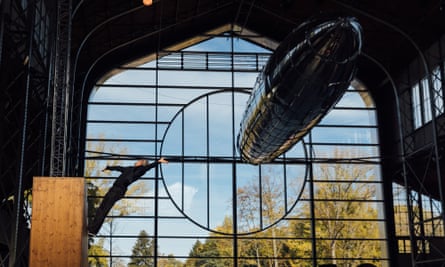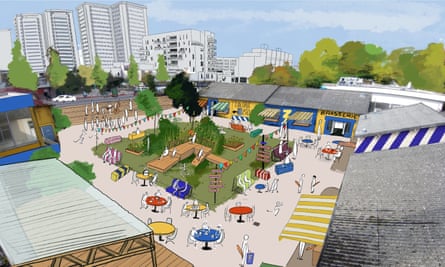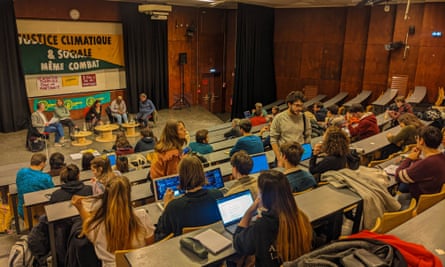An enormous art nouveau greenhouse rises from the Meudon forest, its front made entirely of glass. Inside, suspended from the ceiling, is a 21-metre-long shiny, inflatable zeppelin, which looks as though any minute it might burst through the facade’s central circular pane.
The airship is a permanent, site-specific artwork by Korean artist Lee Bul, designed to draw attention to and define the huge space: this is Hangar Y, the world’s first airship manufacturing hangar, built in 1878. Less than 10 miles south-west of Paris, it churned out airships and hot-air balloons until the end of the first world war. After a brief spell as an aeronautics museum, it was abandoned and left empty for 40 years.
Hangar Y is one of a number of empty or disused buildings in the Paris region that are being dusted off, renovated and given a new life. Abandoned urban plots – or friches – are being transformed into cultural hubs with a variety of uses, exhibition spaces, concert halls, workspaces, premises for charities and venues for popular club nights.

“Hangar Y is a remarkable site and famous in the world of aeronautics,” said general manager Aideen Halleman. “The idea is to create a site with a dual purpose of events and culture – and with such a massive space, we can do really large-scale events.”
In its heyday, three 100-metre-long airships could fit inside the 2,800 square metre hangar. When it opens in March, exhibitions will take place on an extensive mezzanine area, with the rest of the space used for concerts, conferences and a virtual reality experience telling the story of the building. The first exhibition will cover the history of aeronautics, with artworks loaned by the Tate and private collectors such as Henri Seydoux (father of actor Léa Seydoux, who is a connoisseur of aviation memorabilia). A large sculpture park curving around the lake outside will have site-specific installations and immersive sound experiences, with work by international artists including Subodh Gupta, Olafur Eliasson and Kiki Smith.
Renovating and reusing existing buildings is nothing new, but over the past few years, restored friches have become popular hangouts for Parisians: established party spots Le Hasard Ludique and Ground Control were both opened in former railway premises; le 6b, an old office block in the northern Saint-Denis suburb, houses artists’ studios as well as entertainment space. A friche in neighbouring Épinay-sur-Seine looks set to become this summer’s new party destination: Éclair is run by the event organiser Soukmachines, known for its large-scale, raucous parties and transformation of friches around Paris. It is turning the abandoned premises of veteran French film company Éclair into what Soukmachines founder Yoann-Till Dimet calls a “hybrid space for gargantuan events,” opening in June 2023.
Eclair’s place in French cinema history can’t be overstated: most French films in the 20th century probably passed through its laboratories at some point, and its cameras were favoured by directors including Jean-Luc Godard. The offices are a warren of small, windowless studios and projection rooms once used for voiceovers, film development and restoration. Their soundproof cladding will come in handy when Soukmachines transforms the building into studio spaces for dancers, theatre companies, musicians and designers.

“That’s why we’re called Souk – but instead of market sellers, we have artists,” said Dimet as we toured the site, pointing out where they plan to set up a concert hall, dancefloor, bar and theatre. “I think lots of tourists would like to see another side to the city, places that are more unconventional. When we go to Paris, we see the Eiffel Tower, Nôtre-Dame, the Louvre. But it’s good to leave historic Paris and go where Parisians go.”
In a busy capital city, where space is at a premium, the authorities have thrown their support behind projects reviving derelict spaces. The national urban planning agency, Cerema, has even started to track empty plots with crowd-sourced map, Cartofriches, to encourage collectives to take advantage of empty property.
There are clear benefits for property owners: an otherwise empty building is renovated and they can even earn some rent in the process.
after newsletter promotion
“It’s more interesting and financially more advantageous than hiring a security company to stop squatters moving in,” said Victor Houillon of the Plateau Urbain cooperative, which has recently taken over the Sorbonne’s former Censier campus in central Paris with its new project Césure. Plateau Urbain rents out space to student societies, local charities and artists at prices 60% lower than the market rate, and will renovate the rundown building for social projects.

In one former classroom, a student association has set up a food bank for students. Bags of potatoes are piled along one wall, next to crates of fruit and vegetables waiting to be sorted into food baskets. Nearby, an echoing hall that used to be a library could be used as a food market, a showroom for resident artists or even become a roller disco at the weekend.
“Tourists will find a different creative programme here from what you would find in other big cultural venues,” said Angèle de Lamberterie, Plateau Urbain’s director of development.
“It’s important to have spaces in town centres that aren’t solely commercial,” added Jeanne Yanopoulos of urbanism company Yes We Camp, which is working alongside Plateau Urbain. She wants the space to be environment-friendly, and for visitors to be able to spend time there without buying anything: “We are trying to foster tourism that is less passive, less focused on consumption. We want visitors to see that Paris is at the forefront of climate issues.”
The old university halls already have a village atmosphere, with artists and workers arriving on site every day. It will officially open to the public at the end of spring, a further addition to Paris’s clutch of friches and a great example – in a densely populated city – of the way unused urban areas can be transformed into spaces that serve the community.
 Top Naija News – daily news updates in Nigeria | breaking news naija Welcome to Top Naija News, your ultimate destination for daily news updates in Nigeria. We are a dedicated news curation blog from various sources.
Top Naija News – daily news updates in Nigeria | breaking news naija Welcome to Top Naija News, your ultimate destination for daily news updates in Nigeria. We are a dedicated news curation blog from various sources.



